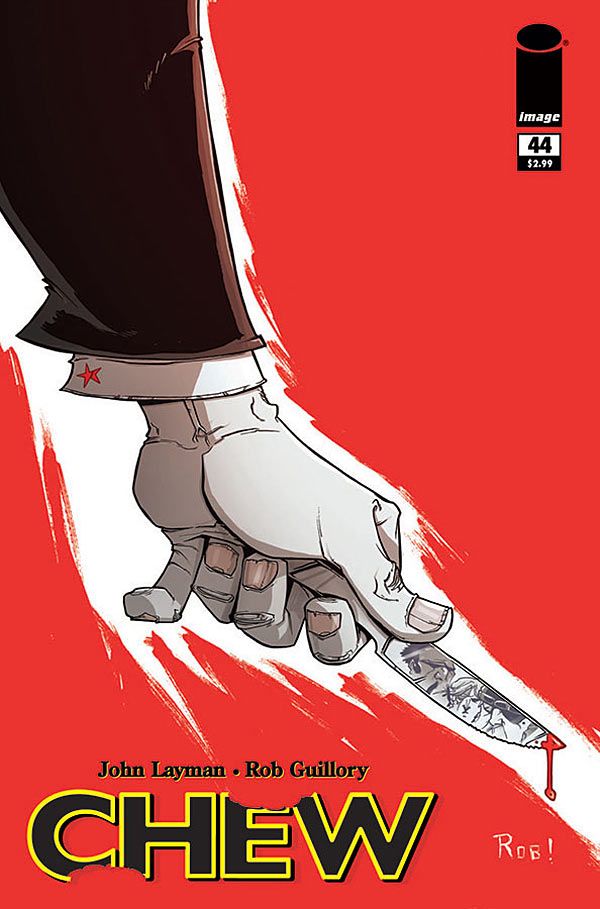"Chew" #44 by John Layman and Rob Guillory is meaty, but the meat is bloody and raw. The FDA crew goes after The Collector, and in the mayhem that follows, many of them get the chop. There's a lot to swallow and not much time for the stomach to settle. Most of the dead or maimed are characters that have been around since the first arc, if not the first issue.
The story begins with a gentle lead-in before Layman punches the reader in the gut. "Chew" #44 begins a short food bio of one Mantou Tang (his name is a kind of bread roll in Chinese), originator of a branch of martial arts that combines cooking and war. His descendent is revealed as another of the The Collector's victims, and with this neat segue, Layman makes a sharp turn and plunks the reader into the middle of the FDA's fight.
From then on, "Chew" #44 is fast and relentless, but there are strategically placed pockets of relative calm in the storm of bloodshed. In the middle of the fight, there's another food biography of a hitherto unrevealed victim of the Collector. The power is a throwaway in the villain's arsenal, but it's a hilarious reference to a well-known cartoon character. Yet another food biography introduces "Babycakes," and there's also a double-paged spread of Poyo. The ending is a classic move that Layman executes perfectly. He flashes back to Tony's reaction to the mission, closing "Chew" #44 with an incomplete circle back in time that ends with the FDA approaching The Collector's doorstep.
When one or more major characters die, there's both the immediate effect and the larger importance to the story to consider. Through the sheer volume of slaughter, Layman succeeds with the shock value, a noteworthy accomplishment in a long ongoing series in which bizarre events occur every few pages and in which there has already been a significant death.
For all the action there is in "Chew" #44, it's extremely simple in substance. It's all blood. The plot is a slaughter when boiled down to the essentials. What makes this bearable is Layman's writing skill and Guillory's facial expressions. Layman's finesse with the timeline adds plotting texture, and the dialogue and Guillory's depiction of the FDA team interactions add depth. Guillory also has his usual humorous background details. His cartoony style, so perfect for comedy, proves itself flexible enough for an issue with the most fight sequences yet. Guillory's art is also is a surprisingly strong vehicle in which Layman can store an accumulation of tension so thick that it feels like horror. The pacing in "Chew" #44 is extremely controlled, as if the container of the narrative structure needed to be reinforced to hold all the swirl of violence within.
It's reminiscent of "Game of Thrones" in how Layman is willing to kill off major characters. Do these deaths serve a purpose beyond the shock value of so many falling at once? Layman hasn't retconned any deaths, but Toni has been pretty active as a ghost. In "Chew," Layman consistently uses flashbacks as a narrative technique, so it's probably not the last time the reader will see the characters affected by The Collector's brutality.
The lasting effects will be in the shape of the future arcs, as the event of Tony Vs. The Collector approaches. It's mechanical kind of stage management, but Layman has removed a lot of Tony's support system, though he notably leaves at least two people close to Tony alive. For the final fight, he has deleted the logical possibility of Tony having the firepower of the FDA at his back. He raises the stakes against Tony, while also making Tony's decision to fight alone a less butt-headed decision by removing obvious options. Also, Layman has given The Collector greater stature. He's a villain that is truly formidable.
Now the anticipation is even higher for the final showdown. "Chew" #44 proves that Layman and Guillory can still deliver on jokes and characterization, while also serving up an unprecedented level of non-comedic carnage.

